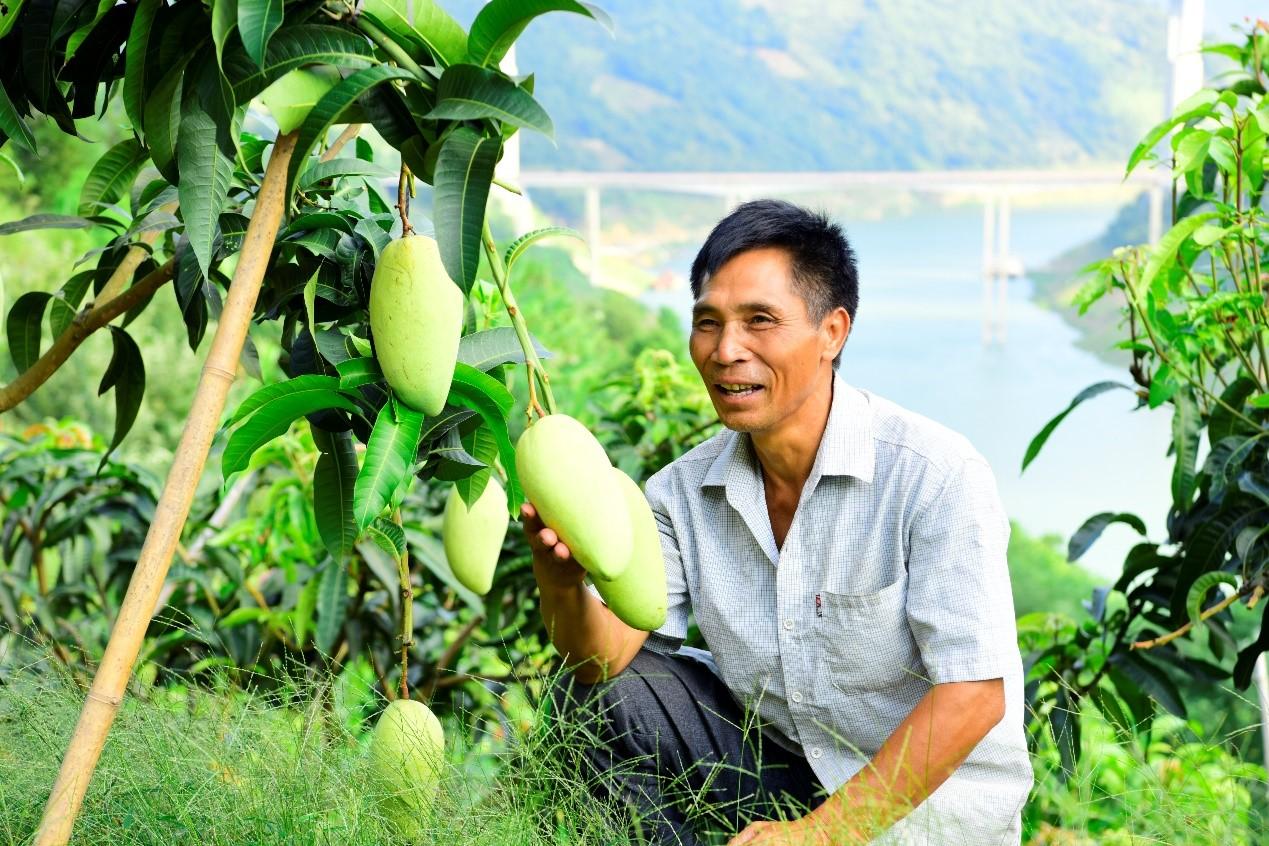
Wang Xianzhi, founder of the Pingbu Village, Youmai Yao Autonomous Township, Mango Farmers’ Cooperative, which is located in Wangmo County, Qianxinan Bouyei and Miao Autonomous Prefecture, Guizhou Province, poses with some mangoes in the organisation’s orchards while inspecting their maturation.
Located where the slopes descending from the Yunnan-Guizhou Plateau, which is also referred to by the abbreviated Yungui Plateau name, transition into Guangxi Zhuang Autonomous Region’s rolling hilly regions near the point at which the administrative area converges with Yunnan and Guizhou provinces in the southwest part of the Guizhou side in southwest China, Mashan is an ethnic minority region that has been suffering from serious rocky desertification. Most of its topography is marked by contiguous concentrated karst formations that are interspersed with steep slopes, deep valleys, and fragmented swaths of flat land. The climate in the area is relatively dry; the soil is thin and generally of poor quality; little surface water exists; and cracks and crevices in bare rock are often the only places where vegetation is able to grow.
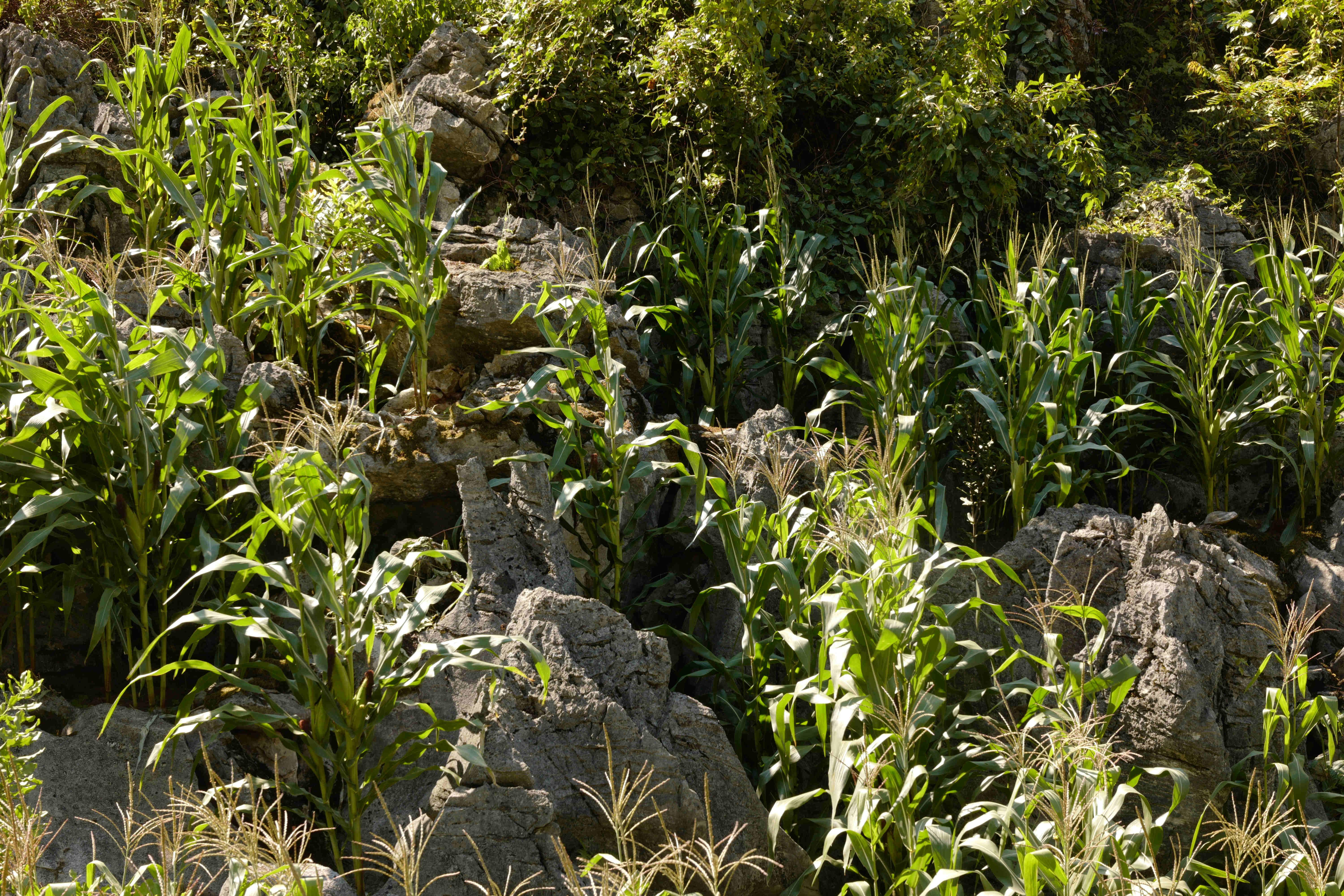
Crops growing in a rocky karst desertified area in Wangmo before a team of experts from the Chinese Academy of Tropical Agriculture Sciences (CATAS) Tropical Crops Genetic Resources Institute (TCGRI) and the Guizhou Institute of Subtropical Crops (GISC) introduced the mango to farmers living in the area.
Situated on the eastern side of the Yungui Plateau, Wangmo County, Qianxinan (which means “southwest Guizhou”) Bouyei and Miao Autonomous Prefecture; Qiannan (which means “south Guizhou”) Bouyei and Miao Autonomous Prefecture’s Luodian, Huishui, and Changshun counties; and Ziyun Miao and Bouyei Autonomous County, which is located in central Guizhou’s Anshun City, comprise the heart of Mashan and have historically experienced widespread poverty. Wangmo’s residents tended to grow corn for a living, which is suited to the county’s rugged, eroded topography, but yields were far below the national average. Pear and tung tree farming was also pursued, but the endeavours did not yield much profit.
The situation began to change when a team of experts from the Chinese Academy of Tropical Agriculture Sciences (CATAS) Tropical Crops Genetic Resources Institute (TCGRI) and the Guizhou Institute of Subtropical Crops (GISC) travelled to Wangmo’s Youmai Yao Autonomous Township in early 2011. The team conducted field research and determined that the warm, dry climate that exists in the area, which features neither severe winters nor excessively hot summers, precipitation that mostly occurs in the summer, and an average of 339 frost-free days per year, would make the county well-suited to mango farming.
Drawing on their successful experiences helping residents in Panzhihua City, Sichuan Province, eliminate poverty and boost their incomes by pursuing and developing the mango industry, the experts began introducing the tree to Youmai’s farmers. The farmers were sceptical of the undertaking at first, however; since they did not have any previous experience growing the fruit. They worried about what they would eat if they began growing mangoes on land that had been used for subsistence farming, whether the trees could survive in the area, and whom they could sell such high-priced fruit to.
A few residents of Youmai’s Pingbu Village eventually expressed interest in pursuing the undertaking, however. The experts leased some land from them and established a demonstration site on it later that year; provided them with mango saplings, fertiliser, and ongoing technical guidance free of charge; and began a trial cultivation of the large and visually appealing Tainong variety, which features smooth, thick, green, red, and maroon skin and dense, somewhat fibrous, orangish-yellow flesh with apple-mango flavour, the Red Ivory variety, which resembles a young elephant’s tusk, is sweet and fragrant, and has a large, ovular shape and light red skin, and two other varieties in order to encourage the hamlet’s residents to participate in the industry. The experts helped participants tend to their orchards for three years free of charge and handed operations over once they began to profit. They were also aware of the importance of major operations that could help the industry develop taking root in the township and helped promote this outcome.
The trees growing at the trial demonstration site begun to bear fruit in 2013, and an average of 350 kg of yields and RMB5,000 of revenue were achieved per mu in 2014.
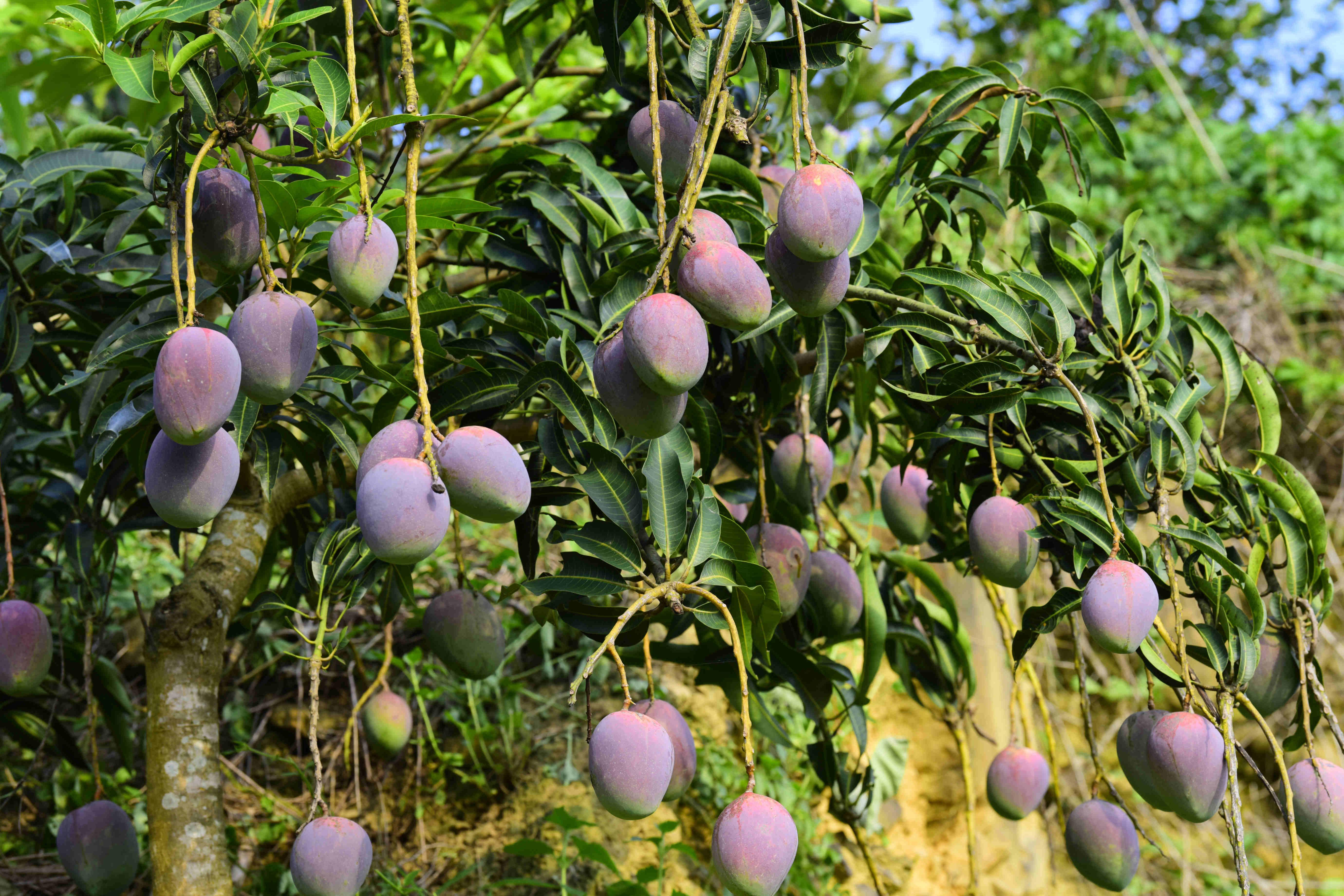
A thriving mango tree growing at the trial demonstration site established by a team of experts from the CATAS TCGRI and the GISC in Pingbu.
Attracted by the favourable conditions associated with the endeavour, Pingbu resident Wang Xianzhi began growing mangoes on 22 mu of his family’s unused land in 2013 and became one of the forerunners in the village in this area. In 2016, the first group of trees that he planted began to bear fruit, which doubled the family’s annual income and enabled them to emerge from poverty.
“We mostly grew corn in the past and attained about RMB600 of revenue per mu but are now able to generate more than RMB6,000 of revenue per mu with our mango trees,” Wang noted in an interview in early 2021.
He also mentioned that his family’s mango grove yielded a total of RMB90,000 of revenue in 2019 and that he was able to do similarly well in 2020, despite the fact that the orchard had sustained some damage from hailstorms that year.
More and more people became interested and willing to participate in the industry when they began seeing the benefits of doing so. Wang established the Pingbu Village, Youmai Yao Autonomous Township, Mango Farmers’ Cooperative in October 2014 and began leasing 300 mu of land in 2015 in order to expand operations. The CATAS TCGRI and GISC also established several technical groups that began providing guidance to farmers in various locations across Wangmo and showing them how to grow and take care of mango trees.
“I knew nothing about mangoes at the very beginning and learned a lot from the experts during the first three years,” Wang noted.
He has become an expert in mango farming after familiarising himself with the standardised techniques that he was taught and implementing them for over a decade, and the per-mu yields and quality of his fruit have been improving by the year.
Wang also remarked that his family has been expanding their operation and was cultivating mango trees on 448 mu of land at the time he was interviewed. He stated that they will thus bring in more than RMB2.69 million of revenue per year when all of the trees are in their full fruit-bearing age if RMB6,000 is generated per mu and that this should result in more than RMB1 million of net income after overhead is deducted. The farmer chuckled that he had never dreamed of obtaining this good of an outcome before.
Wang became confident about expanding the size of his mango orchards and getting most of the 287 households in the village involved in the industry as a result of the quality of the fruit that was being produced and also due to the fact that he had learned from the experts that their mangoes ripen later than those produced in Guangxi and south China’s island Hainan Province but earlier than those that come from Panzhihua, thus avoiding their peak seasons and filling a gap in the market. He thought that these kinds of advantages would enable him and the other farmers in the area to sell their fruit at good prices.
“Our mangoes are very popular,” Wang stated proudly. “Merchants from Henan, Hunan, Jiangsu, Guangdong, and other provinces come to purchase the fruit every year, and we are able to sell all of it.”
The undertaking has also helped combat the desertification that Pingbu had suffered from due to reasons such as bad irrigation practices and other human activities and climatic variation and change since mango groves have the ability to prevent erosion by fixing loose earth and improving soil quality.
Wangmo began promoting the industry in nine more townships that are suited to mango cultivation in its borders in 2016 after Youmai began experiencing success in this area. At the end of 2019, the trees were being grown on 56,500 mu of land throughout the county, and they were planted on another 50,500 mu in the following years. A total of 56,000 mu’s worth of the county’s mango groves bore fruit in early 2023, which has enabled more than 20,000 farmers to increase their incomes.
More than 6,000 mu’s worth of fruit-bearing mango orchards existed in Youmai as of late May 2023, nearly half of its mango trees had entered the full fruit-bearing stage, and the orchards are expected to produce 2,400 tons of mangoes and generate RMB17 million of revenue for the year. The town’s mango revenue is expected to rise to more than RMB30 million when all of its 13,000 mu of mango groves enter the full fruit-bearing stage.
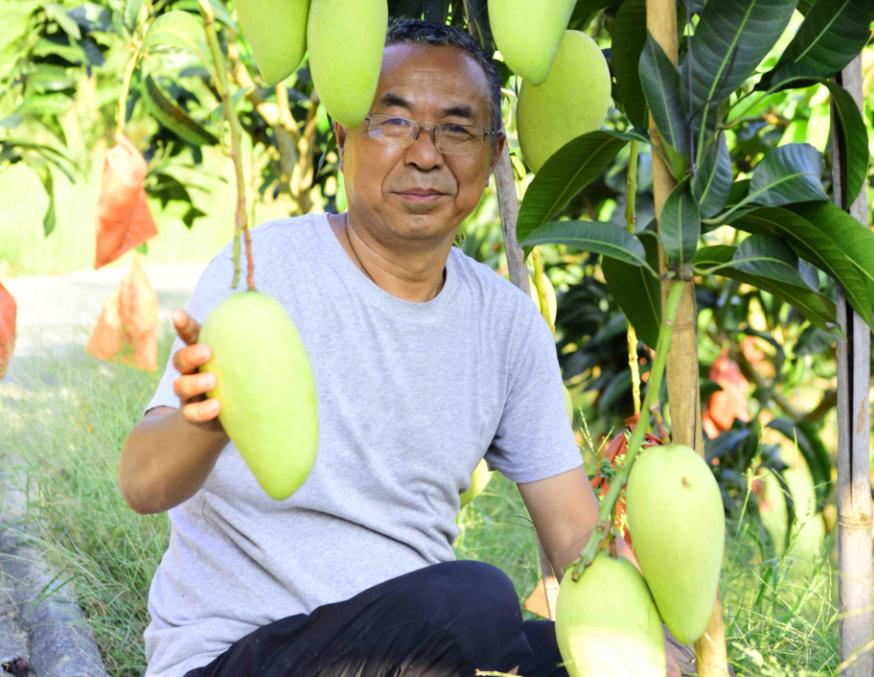
CATAS TCGRI expert Liu Qingguo poses in front of a mango tree at the Youmai Yao demonstration base in Wangmo. He helped introduce a mango industry development plan at the site.
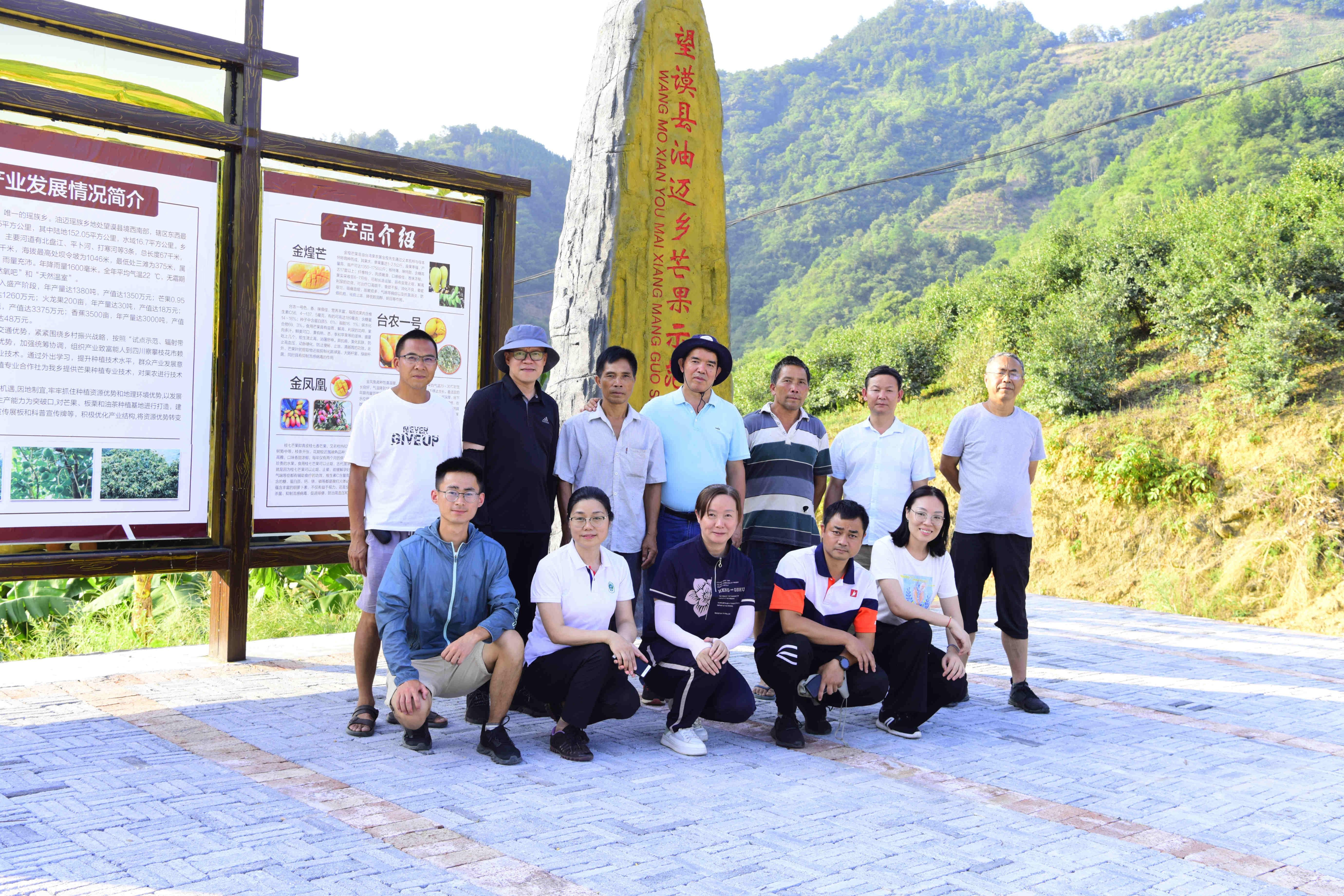
Agriculture experts pose in front of the mango demonstration base in Youmai.

For more information, please contact WFP China COE (wfpcn.coe@wfp.org)
Related Links:
Guizhou Scientist Helps Protect and Enrich Mountainous Karst Hometown with Macadamia Trees
The Rocky Areas' Road to Prosperity: Expert Workstations in a Village
The Rocky Areas' Road to Prosperity: Combating Rocky Desertification in Guizhou's Xingyi
Category
Mangoes Help Guizhou's Karst Mountainous Mashan Region Combat Rocky Desertification and Poverty
Contributor
Mangoes Help Guizhou's Karst Mountainous Mashan Region Combat Rocky Desertification and Poverty
Country
Story

